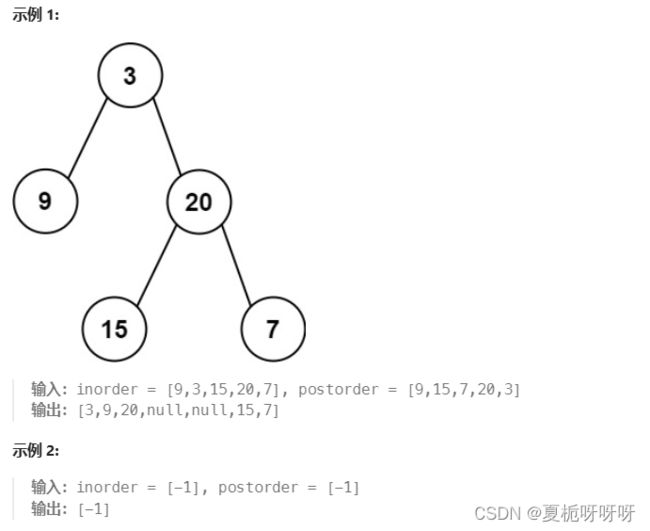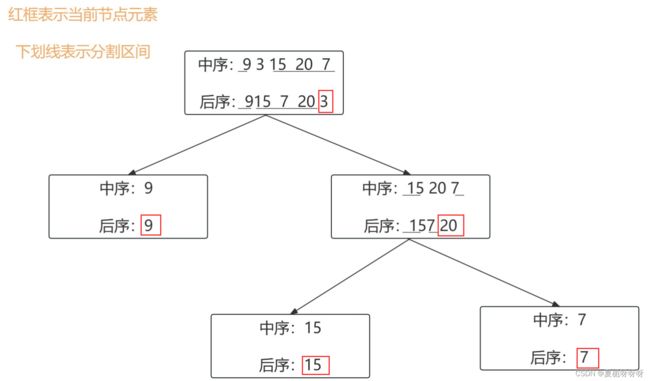【代码随想录刷题】Day18 二叉树05
![]()
文章目录
- 1.【513】找树左下角的值
-
- 1.1题目描述
- 1.2 解题思路
-
- 1.2.1 迭代法思路
- 1.2.2 递归法思路
- 1.3 java代码实现
-
- 1.3.1 迭代法java代码实现
- 1.3.2 递归法java代码实现
- 2. 【112】路径总和
-
- 2.1题目描述
- 2.2 解题思路
- 2.3 java代码实现
- 3.【106】从中序与后序遍历序列构造二叉树
-
- 3.1题目描述
- 3.2 解题思路
- 3.3 java代码实现
【513】找树左下角的值
【112】路径总和
【106】从中序与后序遍历序列构造二叉树
1.【513】找树左下角的值
1.1题目描述
给定一个二叉树的 根节点 root,请找出该二叉树的 最底层 最左边 节点的值。
- 二叉树的节点个数的范围是 [1,104]
- -231 <= Node.val <= 231 - 1
1.2 解题思路
1.2.1 迭代法思路
本题要找出树的最后一行的最左边的值,使用层序遍历是非常简单的,只需要记录最后一行第一个节点的数值就可以了。
1.2.2 递归法思路
题目:在树的最后一行找到最左边的值。
首先要是最后一行,然后是最左边的值。
如果使用递归法,如何判断是最后一行呢?其实就是深度最大的叶子节点一定是最后一行。所以要找深度最大的叶子节点。
那么如何找最左边的呢?可以使用前序遍历(当然中序,后序都可以,因为本题没有 根节点的处理逻辑,只要左优先就行),保证优先左边搜索,然后记录深度最大的叶子节点,此时就是树的最后一行最左边的值。
递归三部曲
-
- 确定递归函数的参数和返回值
参数必须有要遍历的树的根节点,还有就是一个int型的变量用来记录最长深度。 这里就不需要返回值了,所以递归函数的返回类型为void。
本题还需要类里的两个全局变量,maxDepth用来记录最大深度,result记录最大深度最左节点的数值。
int result;// 全局变量 记录最大深度
int maxDepth=-1;// 全局变量 最大深度最左节点的数值
public void traversal(TreeNode root,int depth)
-
- 确定终止条件
当遇到叶子节点的时候,就需要统计一下最大的深度了,所以需要遇到叶子节点来更新最大深度。
if (root.left==null && root.right==null){
if (depth>maxDepth){
maxDepth=depth;// 更新最大深度
result=root.val;// 最大深度最左面的数值
}
return;
}
-
- 确定单层递归的逻辑
在找最大深度的时候,递归的过程中依然要使用回溯
if (root.left!=null){//左
depth++;
traversal(root.left,depth);//回溯
depth--;
}
if (root.right!=null){//右
depth++;
traversal(root.right,depth);//回溯
depth--;
}
return;
1.3 java代码实现
1.3.1 迭代法java代码实现
class Solution {
public int findBottomLeftValue(TreeNode root) {
//迭代法 层次遍历
Queue<TreeNode> que=new LinkedList<>();
que.offer(root);
int res=0;
while (!que.isEmpty()){
int len=que.size();
for (int i = 0; i < len; i++) {
TreeNode tempNode=que.poll();
// 记录最后一行第一个元素
if (i==0){
res=tempNode.val;
}
if (tempNode.left!=null){
que.offer(tempNode.left);
}
if (tempNode.right!=null){
que.offer(tempNode.right);
}
}
}
return res;
}
}
1.3.2 递归法java代码实现
class Solution {
int result;// 全局变量 记录最大深度
int maxDepth=-1;// 全局变量 最大深度最左节点的数值
public int findBottomLeftValue(TreeNode root) {
//递归
traversal(root,0);
return result;
}
public void traversal(TreeNode root,int depth){
if (root.left==null && root.right==null){
if (depth>maxDepth){
maxDepth=depth;// 更新最大深度
result=root.val;// 最大深度最左面的数值
}
return;
}
if (root.left!=null){//左
depth++;
traversal(root.left,depth);//回溯
depth--;
}
if (root.right!=null){//右
depth++;
traversal(root.right,depth);//回溯
depth--;
}
return;
}
}
递归函数简写:
public void traversal(TreeNode root,int depth){
if (root.left==null && root.right==null){
if (depth>maxDepth){
maxDepth=depth;// 更新最大深度
result=root.val;// 最大深度最左面的数值
}
return;
}
if (root.left!=null){//左
traversal(root.left,depth+1);// 隐藏着回溯
}
if (root.right!=null){//右
traversal(root.right,depth+1);// 隐藏着回溯
}
return;
}
2. 【112】路径总和
2.1题目描述
给你二叉树的根节点 root 和一个表示目标和的整数 targetSum 。判断该树中是否存在 根节点到叶子节点 的路径,这条路径上所有节点值相加等于目标和 targetSum 。如果存在,返回 true ;否则,返回 false 。
叶子节点 是指没有子节点的节点。
- 树中节点的数目在范围 [0, 5000] 内
- -1000 <= Node.val <= 1000
- -1000 <= targetSum <= 1000
2.2 解题思路
本题可以采用深度遍历的方式来遍历(本题前中后序都可以,无所谓,因为根节点也没有处理逻辑)。,递归法
2.3 java代码实现
class Solution {
public boolean hasPathSum(TreeNode root, int targetSum) {
if (root==null){
return false;
}
targetSum -= root.val;
//叶子结点
if (root.left==null && root.right==null){
return targetSum==0;
}
if (root.left!=null){
boolean left=hasPathSum(root.left,targetSum);
//已经找到
if (left){
return true;
}
}
if (root.right!=null){
boolean right=hasPathSum(root.right,targetSum);
//已经找到
if (right){
return true;
}
}
return false;
}
}
3.【106】从中序与后序遍历序列构造二叉树
3.1题目描述
给定两个整数数组 inorder 和 postorder ,其中 inorder 是二叉树的中序遍历, postorder 是同一棵树的后序遍历,请你构造并返回这颗 二叉树 。

提示:
- 1 <= inorder.length <= 3000
- postorder.length == inorder.length
- -3000 <= inorder[i], postorder[i] <= 3000
- inorder 和 postorder 都由 不同 的值组成
- postorder 中每一个值都在 inorder 中
- inorder 保证是树的中序遍历
- postorder 保证是树的后序遍历
3.2 解题思路
中序遍历与后序遍历构造二叉树的理论知识
以 后续数组的最后一个元素为切割点,先切中序数组,根据中序数组,反过来再切后续数组。一层一层的切下去,每次后续数组的最后一个元素就是节点元素。
流程如下:
代码该怎样写呢?提到一层一层切割,就应该想到了递归
-
- 如果数组大小为0的话,说明是空节点了
-
- 如果不为空,那么取后序数组的最后一个元素作为节点元素
-
- 找到后序数组最后一个元素在中序数组中的位置,作为切割点
-
- 切割中序数组,切成中序左数组和中序右数组(顺序一定不能弄反了,一定要先切中序数组)
-
- 切割后序数组,切成后序左数组和后序右数组
-
- 递归处理左区间和右区间
3.3 java代码实现
class Solution {
public TreeNode buildTree(int[] inorder, int[] postorder) {
if (postorder.length==0 || inorder.length==0){
return null;
}
return buildHelper(inorder,0,inorder.length,postorder,0, postorder.length);
}
public TreeNode buildHelper(int[] inorder,int inorderBegin,int inorderEnd,int[] postorder,int postBegin,int postEnd){
if (postBegin==postEnd){
return null;
}
//根节点
int rootVal=postorder[postEnd-1];
TreeNode root=new TreeNode(rootVal);
//切割点
int middleIndex;
for (middleIndex=inorderBegin;middleIndex<inorderEnd;middleIndex++){
if (inorder[middleIndex]==rootVal){
break;
}
}
//切割中序数组
//左中序数组,左闭右开[leftInorderBegin,leftInoderEnd)
int leftInorderBegin=inorderBegin;
int leftInoderEnd=middleIndex;
//右中序数组,左闭右开[rightInorderBegin,leftInoderEnd)
int rightInorderBegin=middleIndex+1;
int rightInoderEnd=inorderEnd;
//切割后序数组
//左后序数组,左闭右开[leftPostorderBegin,leftPostoderEnd)
int leftPostorderBegin=postBegin;
//终止位置是 需要加上 中序区间的大小size
int leftPostoderEnd=postBegin+(middleIndex-inorderBegin);
//右后序数组,左闭右开[rightPostorderBegin,leftPostoderEnd)
int rightPostorderBegin=leftPostoderEnd;
int rightPostoderEnd=postEnd-1;//排除最后一个元素,已经作为节点了
root.left=buildHelper(inorder,leftInorderBegin,leftInoderEnd,postorder,leftPostorderBegin,leftPostoderEnd);
root.right=buildHelper(inorder,rightInorderBegin,rightInoderEnd,postorder,leftPostorderBegin,rightPostoderEnd);
return root;
}
}
class Solution {
Map<Integer,Integer> map;//方便根据数值查找位置
public TreeNode buildTree(int[] inorder, int[] postorder) {
map=new HashMap<>();
// 用map保存中序序列的数值对应位置
for (int i=0;i<inorder.length;i++){
map.put(inorder[i],i );
}
return findNode(inorder,0,inorder.length,postorder,0,postorder.length);
}
public TreeNode findNode(int[] inorder,int inorderBegin,int inorderEnd,int[] postorder,int postBegin,int postEnd){
//参数里的范围都是左闭右开
if (inorderBegin>=inorderEnd || postBegin>=postEnd){
return null;
}
// 找到后序遍历的最后一个元素在中序遍历中的位置
int rootIndex=map.get(postorder[postEnd-1]);
TreeNode root=new TreeNode(inorder[rootIndex]);//构造节点
//保存中序左子树个数,用来确定后序数列的个数
int lenOfleft=rootIndex-inorderBegin;
root.left=findNode(inorder,inorderBegin,rootIndex,postorder,postBegin,postBegin+lenOfleft);
root.right=findNode(inorder,rootIndex+1,inorderEnd,postorder,postBegin+lenOfleft,postEnd-1);
return root;
}
}



